Lea Wait's Blog, page 294
April 14, 2015
Mystery Shorts?
Jayne here, and no I am not talking about clothing, although I am sure I do have some mystery shorts in my bureau somewhere, ha ha. I write mainly true crime/non-fiction, but in the past I have written short stories, primarily sci-fi/fantasy (yes, I did!). My first six books were about Okinawa, Japan, with three of them fiction (one a children’s book). Although I am researching my new book on cyberbullying, I had an idea for a book of short stories that are mysteries – cold case files type of thing.
Is there a market for a book of short stories like that, or should I consider fleshing them out as possible novels? I have three done already (well, in my head, but all thought out and ready to type). Before I go crazy typing them up, I’d like some feedback.
What are your thoughts on short stories? Better as standalone in a book filled with other author’s short stories, sold to a magazine or other publication, as an e-book, or better as a full novel?
On a side note, by the time you read this I will have been on a panel at UCONN (go Huskies!) about a very interesting case: http://www.washingtonpost.com/national/supreme-court-case-tests-the-limits-of-free-speech-on-facebook-and-other-social-media/2014/11/23/9e54dbd8-6f67-11e4-ad12-3734c461eab6_story.html. This is definitely testing that line between online harassment and freedom of speech, as was a recent incident at UCONN: https://www.reddit.com/r/UCONN/comments/31sul9/ras_for_social_justice_allege_their_antiracism/. It should be an enlightening and lively talk.
I know I’m keeping this short, but it’s an almost three hour drive for me. Wish me luck!
April 13, 2015
The Marvels of MARVEL!
Kaitlyn Dunnett/Kathy Lynn Emerson here. I bet, from the title, that you think I’m going to talk about Marvel’s Agents of Shield. Or maybe Marvel’s The Avengers. Or even Iron Man or Agent Carter. Okay. I admit I have a fondness for movies and TV shows based on comic books—oops! make that “graphic novels”—but in this case, the marvelous Marvel has to do with libraries, specifically the Maine State Library. Unless one of them has switched to writing articles in scholarly journals, it’s unlikely that either Stan Lee or Joss Whedon is involved.
MARVEL! is Maine’s Virtual Library. It is a database accessible either from library computers in the state of Maine or from the user’s home. Repeat: from home.
We all do research online, whether it’s just to find out more about some subject that catches our fancy or because we need detailed information in order to write a scene in one of our books. When I talk to writers about doing research, I am always careful to remind them that depending on online sources is risky. After all, anyone can put up a webpage or contribute an article to Wikipedia. No credentials required. But going online can also yield new sources of information to explore. There are probably whole books written on any given subject, but there may also be articles in periodicals, whether they be popular magazines or academic journals. Once you have the title and author of a book, it’s relatively easy to either buy a copy or borrow one through Inter-Library-Loans. But if it appears that the best or most recent information may be found in a shorter piece written by an expert, that’s where MARVEL! comes in.
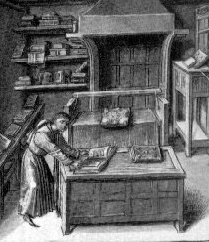
library-old style
At the beginning of April, I was gearing up to start work on the next Mistress Jaffrey Mystery, set in sixteenth-century England. The plot is going to involve a maidservant other characters think is possessed by a demon. I’ve been reading books on demonology and exorcism and taking notes, but before sitting down in front of that blank screen, I wanted to see what else might have been written on the subject. Articles often come out in advance of the publication of a book, sometimes years earlier, so I’ve learned that it’s always a good idea to mine this resource for the most recent research.
MARVEL! is easy to use. Just go to the Maine State Library page, where you’ll find it listed under “Popular Services.” A click of the mouse brings up a keyword search form. I typed in two words: Elizabethan exorcism.
Books also come up in these searches, but the first two items were articles, one in Northern History and the other in History Today. Both had links to see the PDF Full Text version. These can then be read online, downloaded, or printed. Personally, I like the print option, so I can highlight and scribble notes on the pages. Since I’m technologically challenged, it took me a couple of tries to figure out how to print the entire article instead of just the summary, but I now have copies of both articles.
If you already know that an article exists and you’re searching for a copy of it, the same procedure works just fine. Last year, for an entry in my “A Who’s Who of Tudor Women,” I was trying to find an article I’d seen cited in a bibliography. “Thomas Cromwell’s Abbess, Margaret Vernon” by Mary C. Erler was published in the February 2014 issue of History Today, a periodical which makes some of its articles available on its website. When this one wasn’t among them, I turned to MARVEL! I didn’t even have to type in the entire title. The words abbess and Margaret Vernon were enough to take me straight to the article.

circulation and ILL
Mantor Library, UMF
Those examples involve historical research, but MARVEL! works just as well for contemporary subjects. There’s a ball python that makes an appearance in my upcoming Liss MacCrimmon mystery, The Scottie Barked at Midnight. I typed in pythons as pets and MARVEL! produced an assortment of articles and books on the subject. The fourth on the list contained exactly the information I needed in an article in a medical journal.
 As a writer, I love books and I love libraries, but I also love the convenience of being able to find information without having to leave my office. I’ve ordered Inter-Library loans from home for years, through my courtesy card from the University of Maine at Farmington. Thanks to the Maine State Library, MARVEL! makes it even easier for me to do the research necessary to write my books. And if I can’t find what I’m looking for? All it takes to get help is an email to the ILL librarian at UMF or to one of the librarians at MSL.
As a writer, I love books and I love libraries, but I also love the convenience of being able to find information without having to leave my office. I’ve ordered Inter-Library loans from home for years, through my courtesy card from the University of Maine at Farmington. Thanks to the Maine State Library, MARVEL! makes it even easier for me to do the research necessary to write my books. And if I can’t find what I’m looking for? All it takes to get help is an email to the ILL librarian at UMF or to one of the librarians at MSL.
Does MARVEL! or its equivalent exist in other states? I don’t know, but I’d love it if our readers would chime in and answer that question.
April 11, 2015
Greetings from the Crime Wave
This weekend, Kathy, Kate, Lea, Al, and Barb, along with alums Paul Doiron and Gerry Boyle are at the Glickman Library at USM for a day of panels, classes, and schmoozing.
We kicked off last night with Kate, Paul, and Brenda Buchanan and many writers reading a two minute segment of their work. True crime poetry, anyone? A man handcuffed to an anchor? Maine’s premier deathbed artist? There was grace under pressure and a gong and a lot of laughter as we celebrated the courage and talent of a roomfull of writers.
More to come as we enjoy a day with Gayle Lynds, Chris Holm, agent Ann Colette, and others. Will report in during the day (if wifi allows) with highlights.

Sarah Graves and Al Lamanda on the series mystery panel
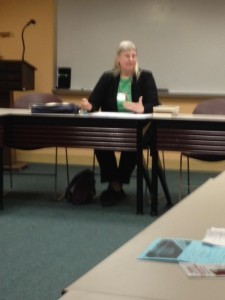
Kathy Lynn Emerson teaching a class on the traditional mystery
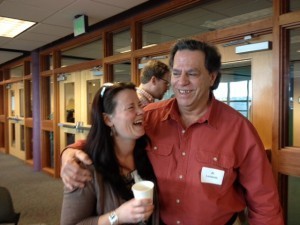
Al Lamanda and his editor, Tiffany Schofield from Five Star at the Crime Wave
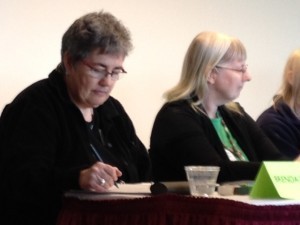
Brenda Buchanan and Kathy Lynn Emerson on a panel about the series mystery

Chris Holm doing a workshop on techniques for creating suspense

Gerry Boyle, Gayle Lynds, Paul Doiron and Lea Wait at the Maine Crime Wave

Gerry Boyle moderates the opening panel at the Maine Crime Wave
April 9, 2015
THANK YOU FOR YOUR SERVICE!
Vaughn Hardacker here: This year there are a couple of anniversaries of major events in my life. On March 6, 1965, the U. S. Marines landed at Danang, Republic of Vietnam, officially kicking off the war, and on June 16, 1965 I graduated high school in Caribou. What do these dates have to do with forming me into the person I am now? Graduating high school says all that needs to be said about that subject. As for the other, within one year I would enlist in the U. S. Marine Corps and in another year and a half I would be in Vietnam.

THE WALL by Lee Teter
This year being the golden anniversary of the Vietnam War many veteran’s groups are giving recognition to those of us who were there. As a member of the Marine Corps League, I did some research into our state’s contribution to that war. I decided to put my focus on those who made the ultimate sacrifice and was surprised to learn some eye-opening facts: Over 340 men gave their lives (I have one source putting the actual number at 341 and another at 343 (this equates to 5.8% of the total dead), I have not been able to find the discrepancy between the two numbers. The first casualty from Maine was Captain Herbert F. Hardy, US Army. He died as a result of enemy action on March 4, 1964. He was from Great Pond in Hancock County. The second and third casualties were Captain Roger E. Gauvin, U.S Army and Private First Class Richard P. Bubar, both of Caribou. Richie Bubar died on November 1, 1964. His death hit me particularly hard as I knew him personally and his parents and mine were very close friends. The first U. S. Marine to be killed in Vietnam was Corporal Gary D. Tracy from Limestone, who was killed on June 6, 1965. The last Maine serviceman to lose his or her life in Vietnam was Lieutenant Commander Robert S. Graustien, US Navy, of Fryeburg in Oxford Country. The youngest Mainer to lose his life was Private Bruce A. Abdellah, US Army, of East Holden in Penobscot County. Who was 95 days short of his twentieth birthday when he was killed on October 26, 1971. According to the National Vietnam Veterans Foundation, five men killed in Vietnam were only sixteen years old and the oldest killed was sixty-two and 61% were twenty-one (I celebrated my twenty-first birthday there) or younger. The war still lingers on in those of us who are still alive and many of us are still reluctant to talk about our experiences with anyone but another Viet-vet. As a matter of fact, we still harbor a great deal of resentment about the way we were treated when we returned. The general attitude about the war and those of us who served there was so negative that we were virtually driven underground. Even today, when attitudes have softened, I bristle when someone says, “Thank you for your service.” Unfortunately, I feel that the phrase has become another platitude (like “Have a nice day” that has no feeling behind it) and my first reaction is to ask myself “Why weren’t we told that forty-six years ago?” and I seldom, if ever, answer the so-called well wisher. There is, however, one statement that enrages me more than that: “I didn’t go over but wish I had.” My answer to that has always been: “Well, trust me when I say you didn’t miss anything.” Of the 2,709,918 Americans who served in Vietnam, less than one-third are estimated to be alive today, with the youngest American Vietnam veteran’s age approximated to be 54 years old. According to the 1995 census 1,713,823 of those who served in Vietnam were still alive; 9,492,958 Americans falsely claimed to have been there. (During the most recent census 13,853,027 falsely claimed being here, so FOUR OUT OF FIVE who claim to be vets are NOT.) The census taken during August of 2000 estimated the Vietnam veteran population surviving at 1,002,511 or a net loss of 711,000 during the five years 1995 to 2000. That’s 390 per day.

Corporal Vaughn C. Hardacker, USMC, in the summer of 1968. Serving as a door gunner with VMO-2
To those of you who say: “Thank you for your service.” Our war has been over for forty something years and many of the younger people thanking us are most likely not aware of the scathing comments and actions to which we Vietnam veterans were subjected upon our return. So I must say that Vietnam veterans need to put the negative feelings behind us and accept the phrase for what it has become, another stranger saying “Good morning” as we pass on the street; just a way of greeting someone (who we really don’t care if their morning is good or not).
When I meet with other Vietnam Veterans and we talk about the war, the question: “Knowing what you know now, would you do it again?” The answer from me and my colleagues (almost exclusively Marines) is “In a heartbeat!” But that is the way we Mainers are. Every Mainer has relatives who fought in our nation’s wars. My uncle, Vaughn L. Hardacker of whom I am his namesake, gave his life in August of 1944 fighting in the hedgerows of France, his youngest brother, Elias (Earl) E., was awarded the silver star in Belgium in December 0f 1944.
In closing, before saying, “Thank you for your service” take a moment to reflect about what you’re saying. If you’re saying it without truly meaning it, just say “Good morning”. Also if a Vietnam veteran stares at you and walks by without answering, please realize that some of us are still not used to dealing with gratitude from the general public and aren’t entirely sure how to respond.
The absent-minded writer
Kate Flora here, in the nidst of a flurry of library appearances that made me totally forget it was my day to blog.
At a delightful Chats with Champions event at the Skidompha library in Damariscotta this snowy morning, we were talking about secrets, the influences of Maine on our writing, and about the many fascinating things people tell us that become parts if stories or aspects of the characters we create.
Barbara Ross and Dorothy Cannell are so funny in person you would have thought you were watching an episode of Comedy Central. Who knew a group of solitary women who kill people for a living could be so silly?
Over lunch , we coined a new term for our characters who grow old much more slowly than we do–that they grow old in Sue Grafton time.
April 8, 2015
Four Principles of Book Promotion
Hi. Barb here.
So, on my last turn here at Maine Crime Writers, Inc., I wrote a post that went a little viral–Four Lies Book Publicists Will Tell You. And by viral, I don’t mean You-Tube kitten viral. I mean it pinged around our little, itty, bitty corner of the universe for a few days. I add this caveat, because being realistic is one of the things this post is about.
At the end of that post, I promised to write another that focused on what I think you should do to promote your book, not what you shouldn’t. It seemed only right to add to the conversation in a constructive way and not just shoot ideas down. Four Principles of Book Promotion is the companion piece to Four Lies.
Apology: First off, I need to apologize to book publicists. As one of them pointed out in the comments section of the original post, I used publicists as a stand-in for all book marketing types and gurus. Believe me, you can get absolutely terrible advice from many, many quarters. And, as Jane Friedman noted in her comment, most of it will come from your fellow aspiring and about-to-be-published authors, who pass myths-and-legends around like hopped up amphetamine freaks trading tips about where to get the next fix. (My words, not Jane’s.) A post about the Fear, Uncertainty and Doubt your fellow writers pass around could go on for days.
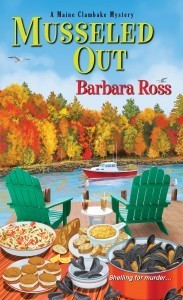 My Bona Fides: So how do I get off offering advice anyway? Just to be clear, here’s my story in a nutshell. I published my first mystery, The Death of an Ambitious Woman, in 2010 with a small press (Five Star, which is a division of a giant company best known for textbooks, Cengage). In 2012, I signed a three book contract with Kensington (a medium-sized, family-owned publisher best known for genre fiction) and the first book in my Maine Clambake Mystery series came out in September 2013. Clammed Up debuted and spent four weeks on the B&N in-store mass market paperback bestseller list. My agent called it, “about the best launch I could have imagined.” Boiled Over came out in 2014 and Musseled Out will launch later this month. Last August, Kensington renewed the series for three more books.
My Bona Fides: So how do I get off offering advice anyway? Just to be clear, here’s my story in a nutshell. I published my first mystery, The Death of an Ambitious Woman, in 2010 with a small press (Five Star, which is a division of a giant company best known for textbooks, Cengage). In 2012, I signed a three book contract with Kensington (a medium-sized, family-owned publisher best known for genre fiction) and the first book in my Maine Clambake Mystery series came out in September 2013. Clammed Up debuted and spent four weeks on the B&N in-store mass market paperback bestseller list. My agent called it, “about the best launch I could have imagined.” Boiled Over came out in 2014 and Musseled Out will launch later this month. Last August, Kensington renewed the series for three more books.
So, I’ve had solid, but certainly not earth-shattering success. I’ve met my personal goals, which were to preserve time to write and to do well enough to get the opportunity to have more books published. Judge that as you will and filter what I tell you here with that knowledge.
I’ve thought long and hard about how to explain what I think you should do to promote a book. There are so many ways to attack it, and goodness knows, millions, maybe billions of words have already be sent out to the universe on the subject. I decided the best first way to tackle the subject was describe the principles that underpin my promotional efforts. I didn’t understand them and certainly couldn’t have articulated them when Clammed Up came out. And something will happened to shift or add to my perceptions tomorrow. But this is what I believe today
Four Principles of Book Promotion
1) Find your niche. In my first post, I introduced this graphic.
As I wrote at the time, this graphic is not to scale. It would be incredibly more discouraging if it was.
Your job as an author is to find out where the people in that bullseye hang out and persuade them to read your book. There is an even smaller group of people within that bullseye who are reading and writing and talking about your type of book all the time. They are the mavens. If you are traditionally published, your publisher is probably already all over them. But you are a person, not a corporation, and people relate to people, so you should get to know them, too.
Yes, it’s true that it is possible to over-spill your niche and go on to meteoric success. We all know the stories. The Hunt for Red October was published by the tiny Naval Institute Press and blew up when Ronald Reagan told a press conference he loved it. Fifty Shades of Grey started out as erotic fan fiction. But here’s the thing, they blew up because they first got people talking about them and passing them around within their niche.
Unless your book went to auction and is being positioned by your publisher as a national bestseller out of the gate, when you’re new, getting the most you possibly can out of your niche is the best, most efficient place to put your promotional efforts.
I was lucky enough to have the second book in my series in both Woman’s World and First Magazine for Woman, general interest magazines, each with a circulation of over a million. The mentions were positive, it was a thrill for me. I will always be grateful. But, first, it’s humbling to see how tiny and hidden the book section of a general interest magazine can be. And second, the results, at least for my kind of book, were infinitesimal compared to the results from a BookBub eblast to people who had already proactively identified themselves as wanting to hear about mysteries that are on sale.
My point is a message to a targeted market beats a mention to an undifferentiated market every time.
The people I’m telling you to look for are even more valuable than the people who’ve given permission to BookBub to send them an e-mail everyday. Because the people I’m talking about will actually read your book. The only way a book develops true buzz is if people are reading it. People buying it and putting it in a pile on their nightstand or in a maze of unread books on their Kindle is pretty nearly useless to you, especially if you are writing a series. When I was in the software business, we used to call sales like these “shelfware.” They barely counted because we knew we wouldn’t be getting any license renewals or selling any add-on business.
How do you find your niche? Find out who’s talking about books like yours. Pick a few similar titles that have come out recently. What book bloggers reviewed it? What Goodreads groups are discussing it? Are there Facebook groups, listservs, conferences focused on your type of book? To find readers, act like the reader you already are, but maybe a shade more fanatical. Go on the hunt.
2) Be a person. Ramona DeFelice Long is laughing because she knows this is my go-to advice for people about how to behave on social media. But it is also my advice about how to behave in general. Be a person first, and a reader second, and a writer third. Chances are you are all those things in more or less that order anyway. In other words, be your authentic self.
Books are intangible products. In their print form that may appear not to be true, but people aren’t buying the physical object, they are buying the story. And they can’t experience the story before they read it. So they count on various factors to help them decide whether your book is going to be a worthwhile use of their money and time. The most important deciding factor is if they’ve read another book of yours and loved it. As I said in Part I, your book sells your next book. The second most important factor is recommendations from people they trust. The trust part is important, because unlike a tangible product, readers cannot hold your story in their hands. They are taking a leap of faith when they commit to it.
Intangibles are sold person to person, via trusted relationships, be it online relationships or carbon-based ones. That’s why it’s so horrible and jarring when your first interaction with an author is “Buy my book,” or “Like my page.” It’s a request, but it feels like a demand. Your reaction is visceral and along the lines of, “I don’t know you, Bud. I don’t have any reason to trust you, and I’m starting not to like you.”
So your first interactions with people should be person-to-person, reader-to-reader.
Once you’ve found your niche, participate. Like a person. Like a reader, and finally like a writer. Once you’ve established a relationship, you can ask, nicely, if a book blogger would like an Advance Reader Copy of your book. Or mention that your book is being discounted this month. Or point out a great review. But be sparing of that stuff. A little goes a long way. Remember that guy in your high school class who became an insurance salesman? You liked him and even trusted him, but you only wanted to hear so much about insurance. As the author, you’re uniquely situated to help people understand why they would enjoy reading your book. But first you have to be a person they trust.
3) Seek safety in numbers. In Lies, I talked about the value of being a part of a network of writers. I can’t tell you how much that has helped me. Doing a bookstore or library appearance alone, when your name is not known, can be fairly horrifying. Doing it with a friend or three, will increase the crowd, (they attract a few people, you attract a few people) and take some of the pressure off. And for a lot of writers, talking about how great someone else’s book is, is much easier than blowing their own horn.
Some experts pooh-pooh the notion of group writer blogs like this one, but Maine Crime Writers and Wicked Cozy Authors, the other group blog I am a part of, have been invaluable to me. It’s not so much the daily blog itself, though that is the foundation. It’s the opportunity to create an umbrella brand that is larger than yourself, and which enables you to do things like have a joint newsletter, set up events or have a much larger and more visible presence at conferences.
Musicians tour together. Comedians have opening acts. Writers are no different. We may write alone, but we can and should promote in groups.
4) Calm the Heck Down. There’s a lot of reasons novelists on the cusp of publication are quivering piles of goo. (I write about some of them on Wicked Cozy Authors here.) You love your book. You want to do the absolute best you can to promote it. And you should.
But you should also Calm the Heck Down. You’ve wanted this for a really long time, and now it’s here. Enjoy the ride.
Because here’s what I’ve concluded, after observing my own efforts and those of my friends. All your promotion will probably only move the needle on sales by about 10 or 15%.
At the end of the day, you can’t outrun the appeal of your story to your target audience, and the distribution capability of your publisher (however you choose to publish). Those two things are determinant.
Remember way back there in the post, when I gave you my bona fides? When people ask me why I think Clammed Up was successful, here’s what I tell them. My publisher got me a cover that people really responded to and paid for terrific placement in Barnes & Noble. (At least in the ones I went in. Publishers actually don’t talk to you about this stuff much when you’re the author) After seven months on the market, my publisher put the ebook edition on sale and got it on BookBub.
Those efforts resulted in the vast bulk of the sales.
What did I do? I wrote the best book I was capable of writing at the time. The book was nominated for several awards, and that kept people talking about it. I made sure my friends, family, fellow writers and the tiny fan base I’d accumulated from Death of an Ambitious Woman knew about the book. I went where people asked me to go, guest blogged in my niche, visited with Goodreads groups and book clubs that had, independently of me, decided to read the book.
My efforts were incremental, best case.
As I said in the original post, now that I have fans, I treasure them. I make sure they have multiple ways to find me, and that I have multiple ways to communicate with them. But there is only so much you can do to promote your book.
So relax. The odds are very small that you alone can turn your book into a bestseller. But the odds are also very small that you can truly screw it up. Take you job seriously, but have fun with it.
Because if you’re not having fun, why are you doing this at all?
April 6, 2015
Fondue Days
My first out-of-college job was as a first level manager at Western Electric, then the manufacturing and supply arm of the Bell System, in downtown New York City. It was the spring of 1968. Students were protesting, the World Trade Center was rising, and the Vietnam War and assassinations in the United States filled the newspapers.
I was the only management woman in the public relations department, and I was twenty years old. I had a lot to learn.
I learned to write to different audiences: not just executive speeches, in the style of a particular man (all the executives were, of course, men,) but also press releases, with both words and pictures. Employee newspaper articles. Employee films and videos. I spoke to high school classes in New York City about why they should apply to Ma Bell for jobs after they graduated. And I edited articles about engineering and community service activities. When the telephone company operators went on strike, I worked twelve hours a day as an information operator.
But it wasn’t all work. Lower Manhattan was an exciting place, and the young men I worked with (including the one I’m now married to,) often took long lunches, often with alcoholic libations included. In the summer we bought sandwiches and walked over the Brooklyn Bridge and ate on Brooklyn Heights. We headed to Chinatown regularly. And my favorite destination was the tiny restaurant up a narrow staircase above The International Wine and Cheese Shop on Chambers Street.
The first floor was filled with a world of cheeses, most of which I’d never heard of in suburbia. But the second floor was magic. Here a group of us would crowd around one or two tables, drink wine, and share raclette, or a pot or two of cheese fondue. When the cheese got thick, the owner would add more wine or Kirsch.
Lunches there tended to last a lot longer than an hour, and made for afternoons of low productivity.
But I fell in love with the place, the people … and the fondue.
I vowed to learn to make it myself, but with that restaurant so near, I only tried it a few times while I was living in New York.
But a few years later when my job was transferred to New Jersey I spent many evenings experimenting with different combinations of cheeses and wines. By the time my children were teenagers, cheese fondue was a favorite at our house … often followed (especially if we were entertaining) by chocolate fondue for dessert.
Fondue isn’t as popular as it once was. (I actually have an entire cookbook of fondue recipes.) And the couple of times I’ve ordered it in restaurants in the past ten years it didn’t approach the fondues of my memory.
Of course, that smoky second floor room on Chambers Street that smelled of cheeses from around the world was still my standard.
Unfortunately, that shop and restaurant are no longer.
But on a cold winter’s night in Maine, my husband and I sometimes share a pot of cheese fondue, and remember. And the memories warm us as much as does the fondue.
If you don’t have a favorite fondue recipe, here’s mine, for a classic taste. Enjoy!
(serves about 4 as main course … more as an appetizer)
1/2 pound shredded Switzerland Swiss cheese
1/2 pound shredded natural Gruyere cheese
1 clove garlic
1 1/2 cups dry white wine, e.g. Chablis — + more to drink
1 Tablespoon lemon juice
1 Tablespoon cornstarch
3 Tablespoons (or a bit more) Kirsch (Swiss cherry brandy)
pepper to taste
2 loaves Italian or French bread
Shred cheese. Cut bread into 1″ cubes with crust on one side. Rub fondue pot with cut garlic.
Note – although some recipes suggest melting the cheese in the fondue pot, I’ve found it’s easier to melt it on the stove, and then pour it into the (warmed) pot for serving.
Rub pan with cut garlic. Add wine to pan; heat. When wine is hot (not boiling) add lemon juice. Add shredded cheese by handfuls, stirring constantly with a wooden soon until cheeses are blended and melted. Bring to bubble briefly. Add seasonings, stirring until blended. Mix cornstarch with Kirsch; add to fondue and allow to boil another 15-30 seconds.
Serve and keep hot in fondue pot. Stir frequently; if it thickens too much, add wine.
Enjoy!
The Swiss have a tradition that if a piece of bread falls off your fork into the fondue pot, you get a kiss. Following that tradition is not required .. but does liven up the party. And no — that wasn’t a part of business lunches!
April 5, 2015
The Deliberations of the Unconscious Mind: An English Major’s Meditation

Just some twisted roots, or a monster? Old bones? Something waiting to come alive?
Kate Flora: Back when I was in college, shortly after the Mayflower landed, I wrote a paper on flower imagery in one of Shakespeare’s plays. I wondered then, as I have often wondered as a reader, whether the author consciously and deliberately played with flowers and wove those images throughout the play. Indeed, I’ve always wondered how many of the things that writers do with metaphor and simile, and with recurring images and themes, are deliberate on the part of the writer, and how much simply happens on an unconscious, or subconscious level. I don’t have an answer for other writers, but I’m beginning to discover an answer for myself.
It is one of the wonders of this craft I’ve chosen that the learning curve is infinite. Knowing that we all once faced that first blank page with terror, and overcame that fear, and wrote on to our first “The End,” helps me understand that we are a community of learners at all levels. It is a learning process that never stops, and thus, when I’m not overwhelmed, or discouraged with a difficult plot point, or grouching about my lack of greater success, I’m rather awed by it. I’m currently working on either my twenty-fifth or twenty-sixth book, and it’s still exciting to be doing something that is never the same twice, that always has some new challenge to present and some new insight to give. I will come to understand what I’m doing on one level and then have to learn it all over again as the works grow more complex and interwoven, and my characters, with whom I’ve open spent decades observing their development, grow and change and become deeper and different than they were years ago when I first began to write them.
 The ways in which the conscious writer, the one who plants the clues and slowly discloses the plot points, interacts with the unconscious writer, is repeatedly revealed to me as I’m working my way through my fifth Joe Burgess mystery, And Led Them Thus Astray. While I’m trying to work out where the shooter was standing, and who was shot first, what gun to use, and how to approach the scene without destroying essential evidence, I see something else happening in the work. I see that while the mystery is unfolding according to police procedural conventions, something else is happening in the visual and temporal aspects of the book that I did not plan.
The ways in which the conscious writer, the one who plants the clues and slowly discloses the plot points, interacts with the unconscious writer, is repeatedly revealed to me as I’m working my way through my fifth Joe Burgess mystery, And Led Them Thus Astray. While I’m trying to work out where the shooter was standing, and who was shot first, what gun to use, and how to approach the scene without destroying essential evidence, I see something else happening in the work. I see that while the mystery is unfolding according to police procedural conventions, something else is happening in the visual and temporal aspects of the book that I did not plan.
Even as Joe Burgess drives through a gray late afternoon and gets a call to a shooting scene, he is  also moving from day into night, from light into darkness. And as that scene unfolds and he discovers the enormity and complexity of a scene involving multiple victims, daylight fades away. Discoveries are made with flashlights, through small points of light in a vast and unknown darkness. The search team in the woods, seen from a distance, are like fireflies. And when morning comes, what ought to be a lovely late May weekend is smothered in a chilling Maine fog that won’t let up. Light is dimmed. Sounds are muffled. Visibility is limited. The investigators’ discoveries about their shooter, and their shooter’s multiple levels of deception, will take place in a natural world that has deviated from the normal and obscured the light just as the killer has.
also moving from day into night, from light into darkness. And as that scene unfolds and he discovers the enormity and complexity of a scene involving multiple victims, daylight fades away. Discoveries are made with flashlights, through small points of light in a vast and unknown darkness. The search team in the woods, seen from a distance, are like fireflies. And when morning comes, what ought to be a lovely late May weekend is smothered in a chilling Maine fog that won’t let up. Light is dimmed. Sounds are muffled. Visibility is limited. The investigators’ discoveries about their shooter, and their shooter’s multiple levels of deception, will take place in a natural world that has deviated from the normal and obscured the light just as the killer has.
Did I consciously plan this? Absolutely not. Not on the “make an outline” or “consider how characters are revealed to the reader” or “crank up the suspense” level of crime writing. But did I plan this? Absolutely. Because this, for me, is what writing is about. It’s about using all of the things we’ve read and experienced that make fiction work. It’s about trusting our instincts and our imaginations, and putting ourselves in the chair, and in the zone, where writing begins to flow—consciously and unconsciously—into a deeper and more complex kind of storytelling.
Sometimes, when I give an author talk, someone will ask the basic question: What is the book about? What do I want a reader to take away? And the answer happens on many levels. The book is about the dangers to those we ask to do the hard job of policing in society, and how to balance the higher calling of serving and protecting with the desire to live a normal life. It’s about balancing responsibility to family with the responsibility to the weak and helpless and the victims of crime. The book is about people believing they’re entitled to deviate from the social contract.
And if someone were to ask about that imagery of light and darkness? Well, that’s the story of the investigation—from darkness with only pinpricks of light and insight to bringing the facts into the light and restoring order to the world. It is also about the basic struggle between good and evil, and pushing back the forces of darkness. Pretty obvious, right? And yet, the way it plays out can be fascinating.
 Back to the flower images. Yes. This is what an English major thinks about when she cannot leave her desk and go out into the garden and the hellebore is still buried under snow. And when she’s so deeply immersed in a story that the quotidian seems unreal and the imagined utterly real. I can feel that clammy fog on my skin. Hopefully, someday soon, so will you.
Back to the flower images. Yes. This is what an English major thinks about when she cannot leave her desk and go out into the garden and the hellebore is still buried under snow. And when she’s so deeply immersed in a story that the quotidian seems unreal and the imagined utterly real. I can feel that clammy fog on my skin. Hopefully, someday soon, so will you.
April 3, 2015
Weekend Update: April 4-5, 2015
 Next week at Maine Crime Writers there will be posts by Kate Flora (Monday), Lea Wait (Tuesday), Barb Ross (Wednesday), Kate Flora (Thursday), and Vaughn Hardacker (Friday). Please note that next weekend most of us will be at Maine Crime Wave. We hope to post from there during the weekend and will definitely have a Crime Wave wrap-up on Monday, April 13.
Next week at Maine Crime Writers there will be posts by Kate Flora (Monday), Lea Wait (Tuesday), Barb Ross (Wednesday), Kate Flora (Thursday), and Vaughn Hardacker (Friday). Please note that next weekend most of us will be at Maine Crime Wave. We hope to post from there during the weekend and will definitely have a Crime Wave wrap-up on Monday, April 13.
In the news department, here’s what’s happening with some of us who blog regularly at Maine Crime Writers:
from Kaitlyn Dunnett: If you read my last post, Talking Heads, you know that I came in waaaay short of my goal of 75,000+ words on the first draft of the tenth Liss MacCrimmon mystery, Kilt at the Highland Games. As in only 50,829 words. Good news. I’ve just finished the second draft (but by no means the last one) and the word count now stands at a healthy 76,035. Whew! Lots of tweaking left to do, and probably some cutting. Most likely I’ll discover a continuity problem or two. I’ll definitely have to do a search for words I’ve overused. But this was the big hurdle. From here on in, I don’t have to put so much pressure on myself because I know I’ve already met the basic requirements set forth in my contract. I know. I know. It’s all mind games. But I still feel as if a tremendous burden has just been lifted.
From Barb Ross: On Thursday, April 9 from 10:00 am to noon, Dorothy Cannell, Kate Flora and I will be at the Skimdompha Library, “Chats with Champions” speaking on the panel “Three Maine Mystery Writers Share Secrets.” Would love to see you there! 184 Main St. Damariscotta, Maine.
On Saturday, April 11, many of the Maine Crime Writers along with many other great Maine mystery authors will be at the Maine Crime Wave at the Glickman Library at the University of Southern Maine in Portland. You can register up through Tuesday, here. There are also readings and dinners on Friday night.
An invitation to readers of this blog: Do you have news relating to Maine, Crime, or Writing? We’d love to hear from you. Just comment below to share. Don’t forget that comments are entered for a chance to win our wonderful basket of books and the very special moose and lobster cookie cutters.
And a reminder: If your library, school, or organization is looking for a speaker, we are often available to talk about the writing process, research, where we get our ideas, and other mysteries of the business. Contact Kate Flora: mailto: kateflora@gmail.com
April 2, 2015
Rolling Rally Comes to Maine: Presenting the Agatha Short Story Finalists
Kaitlyn Dunnett/Kathy Lynn Emerson here, along with Barb Goffman, Edith Maxwell, and Art Taylor. All of us are finalists for the Agatha Award for traditional mysteries in the short story category. Art is the author of two of the nominated stories. You’ll find links to read them all at the Malice Domestic website. Just click on “awards” and scroll down until you come to the short story nominees.
I’m the only one of us who persists in calling this a rolling rally. No, we don’t have the duck boats used when Boston celebrates championships with the Patriots and the Red Sox, but as far as I’m concerned, we’re all winners. As a group, we’ve been on a blog tour, talking about short story writing. Today we’re here at Maine Crime Writers to answer the following question:
O ne piece of advice often given to writers of short stories is to keep it simple by focusing on one situation, one setting, one point of view, and only a limited number of characters. How hard is it to stick to this “rule” and what were the results when/if you’ve broken it?
Art Taylor:
 Keeping it simple can be good advice in many ways—especially when writing within the often unforgiving constraints of a short story, which doesn’t provide much room for error—and I personally love the tightness of a good single-setting, single-situation story with some tense interplay between just a couple of characters. But more often I find myself trying to stretch the boundaries a little bit, trying to weave together multiple perspectives on the same situation or fold in significant bits of a character’s distant past (or imminent future) or pile on extra layers to what might seem like a straightforward situation. With “The Odds Are Against Us,” for example, I started out with a simple conversation between two old friends, told solely from the perspective of one of them, but I hope that the way the other man keeps keeps thwarting the narrator’s goals and intentions, keeps shifting the direction of the story being told, and keeps bringing up forgotten bits of their shared past—I hope all of that complicates and deepens the “one situation” of the story and adds even more to the already hefty moral weight of the decision the narrator faces, the choice he makes. The success of a short story, to my mind, isn’t just how tightly you can trim it down but more importantly how much can be packed into that little bit of space— not just the precise detailing of what happens during the story but those key glimpses of the characters’ lives before the start of the story and after the end of it too, all those necessary hints of the larger world beyond the edge of the page.
Keeping it simple can be good advice in many ways—especially when writing within the often unforgiving constraints of a short story, which doesn’t provide much room for error—and I personally love the tightness of a good single-setting, single-situation story with some tense interplay between just a couple of characters. But more often I find myself trying to stretch the boundaries a little bit, trying to weave together multiple perspectives on the same situation or fold in significant bits of a character’s distant past (or imminent future) or pile on extra layers to what might seem like a straightforward situation. With “The Odds Are Against Us,” for example, I started out with a simple conversation between two old friends, told solely from the perspective of one of them, but I hope that the way the other man keeps keeps thwarting the narrator’s goals and intentions, keeps shifting the direction of the story being told, and keeps bringing up forgotten bits of their shared past—I hope all of that complicates and deepens the “one situation” of the story and adds even more to the already hefty moral weight of the decision the narrator faces, the choice he makes. The success of a short story, to my mind, isn’t just how tightly you can trim it down but more importantly how much can be packed into that little bit of space— not just the precise detailing of what happens during the story but those key glimpses of the characters’ lives before the start of the story and after the end of it too, all those necessary hints of the larger world beyond the edge of the page.
Edith Maxwell:
 I don’t find it too hard to stick to this rule—but let’s call it a recommendation, shall we? My Agatha-nominated story, “Just Desserts for Johnny,” has one point of view, one essential setting, definitely one situation, and exactly two named characters, so that was pretty easy. I wrote a story a few years ago (“Yatsuhashi for Lance”) that started in Japan and ended in the US a decade later, but the single POV made it work. It was also only one situation, that is, one crime, whether real or perceived.
I don’t find it too hard to stick to this rule—but let’s call it a recommendation, shall we? My Agatha-nominated story, “Just Desserts for Johnny,” has one point of view, one essential setting, definitely one situation, and exactly two named characters, so that was pretty easy. I wrote a story a few years ago (“Yatsuhashi for Lance”) that started in Japan and ended in the US a decade later, but the single POV made it work. It was also only one situation, that is, one crime, whether real or perceived.
In my first historical short story, “A Fire in Carriagetown,” I did have to rein in the number of characters. What I didn’t realize when I wrote it was that it would turn into a full-length novel (Delivering the Truth, coming out next year from Midnight Ink). Maybe I was subconsciously setting up for a longer work. I’ve written two other historical shorts set in 1888 Amesbury, Massachusetts, but they haven’t gone overboard, character-wise, maybe because I already know I have everybody I need in the book. Come to think of it, “Pickled,” a kind of pilot for my Country Store Mysteries series, which debuts in November under the pen name Maddie Day, also initially had too many characters, and also ended up as part of the first novel, Flipped for Murder.
Most important, the story needs as many people as it needs. If there’s anybody who walks through but isn’t critical to the story, you first remove their name, and then see if their action can either merge with someone else’s or be deleted entirely.
As for crimes/situations—I’ve never written a story with more than one. And while I’ve also never written from more than one point of view, even in a book-length work, I plan to try that out. I doubt a short story could tolerate more than two, but hey, I would love to be surprised!
Barb Goffman:
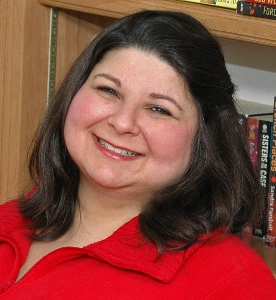 I’ve never heard this “rule” expressed this way before, but it’s good advice. Limiting the number of characters, for instance—each character should have a job to do. If a character isn’t there for a specific reason, cut him. And if one character could do what you have two doing, merge them.
I’ve never heard this “rule” expressed this way before, but it’s good advice. Limiting the number of characters, for instance—each character should have a job to do. If a character isn’t there for a specific reason, cut him. And if one character could do what you have two doing, merge them.
Sticking to one situation is smart, too. When I write a short story, I come up with a conflict (a “situation”). My main character reacts to the conflict and drives the plot. For instance, in my Agatha-nominated story “The Shadow Knows,” Gus hates long winters and believes his town’s groundhog, Moe, is responsible for them. That’s the story’s conflict/situation. Gus reacts to it by deciding he needs to get rid of Moe. And the plot unfolds from there. If, in addition to hating winter, Gus also was low on cash so he decided to rob a bank, that would be an entirely different situation, which should result in a different story. I wouldn’t have the two things occur in the same story—that split focus would annoy the reader and undermine the story’s focus—unless Gus figured out how robbing the bank would enable him to both get cash and get rid of Moe. In that scenario having two situations/conflicts would work because they would become entwined. More power to an author who can do that.
As to how many settings and points of view are in a story, I think—as with characters—you should have as many as the story calls for, but no more. I wouldn’t have characters jetting from one city to another for no reason, but that’s because characters should do things for a plot-related reason, not because multiple settings are inherently bad. In my story “Murder at Sleuthfest,” my main character travels to and from the Sleuthfest convention. Attending the convention is vital to the plot, so she goes. If it weren’t vital, there would be no reason for her to attend, so she wouldn’t go. Similarly with point of view, if I needed two points of view to tell a story, then I would use two points of view. But I wouldn’t have more than two unless I needed them.
Ultimately, every decision about story structure should be driven by the plot. (Character should drive the plot, but plot should drive the structure.) Don’t try to be fancy. Try to write the best story you can, keeping things as tight as you can, by limiting your conflict (situation), setting, point of view, and number of characters to just as many as you need for your story to enfold. I haven’t broken this “rule” myself, but I’ve seen it happen. I edit for a living, and when I see it, I ask the author, “Why is this here? Why is it happening? How does it serve the plot?” By helping authors focus, I help them create tighter, better stories. And that is the ultimate goal: good stories.
Kathy Lynn Emerson:
 One of my first published short stories came out of my affection for a fairy tale, “The Twelve Dancing Princesses.” In “The Reiving of Bonville Keep,” included in the anthology Murder Most Medieval, I created a backstory where an English baron kept marrying to get himself a son and ended up with twelve daughters, the youngest of whom would have been seriously hurting for a dowry and therefore lacking in marriage prospects. Then I threw in a Scottish knight who was married to one of the older girls and came back to Bonville Keep after her death to collect their daughter, who was being cared for by the younger sister. Throw in an evil stepmother and a couple of greedy henchmen and you have a heck of a lot of characters, as well as a complicated situation. To make matters worse, since I didn’t know any better back then, I used two point-of-view characters. Short fiction doesn’t usually get as much feedback as novels, but one of the reviews for this anthology singled this one out as a favorite and another historical novelist, someone I greatly admire, emailed me years after it was published to tell me that it was one of her all-time favorite short stories, so I guess I must have done something right.
One of my first published short stories came out of my affection for a fairy tale, “The Twelve Dancing Princesses.” In “The Reiving of Bonville Keep,” included in the anthology Murder Most Medieval, I created a backstory where an English baron kept marrying to get himself a son and ended up with twelve daughters, the youngest of whom would have been seriously hurting for a dowry and therefore lacking in marriage prospects. Then I threw in a Scottish knight who was married to one of the older girls and came back to Bonville Keep after her death to collect their daughter, who was being cared for by the younger sister. Throw in an evil stepmother and a couple of greedy henchmen and you have a heck of a lot of characters, as well as a complicated situation. To make matters worse, since I didn’t know any better back then, I used two point-of-view characters. Short fiction doesn’t usually get as much feedback as novels, but one of the reviews for this anthology singled this one out as a favorite and another historical novelist, someone I greatly admire, emailed me years after it was published to tell me that it was one of her all-time favorite short stories, so I guess I must have done something right.
I’m pretty sure I make things a lot harder on myself by not keeping things simple, but when characters take on a life of their own, what’s a writer to do?
If you’d like to read what we’ve said at the other stops on the blog tour, here are the links.
February 20 at Criminal Minds
March 6 at Wicked Cozy Authors
March 17 at Writers Who Kill
and still to come, April 20 at The Stiletto Gang
Lea Wait's Blog
- Lea Wait's profile
- 509 followers






